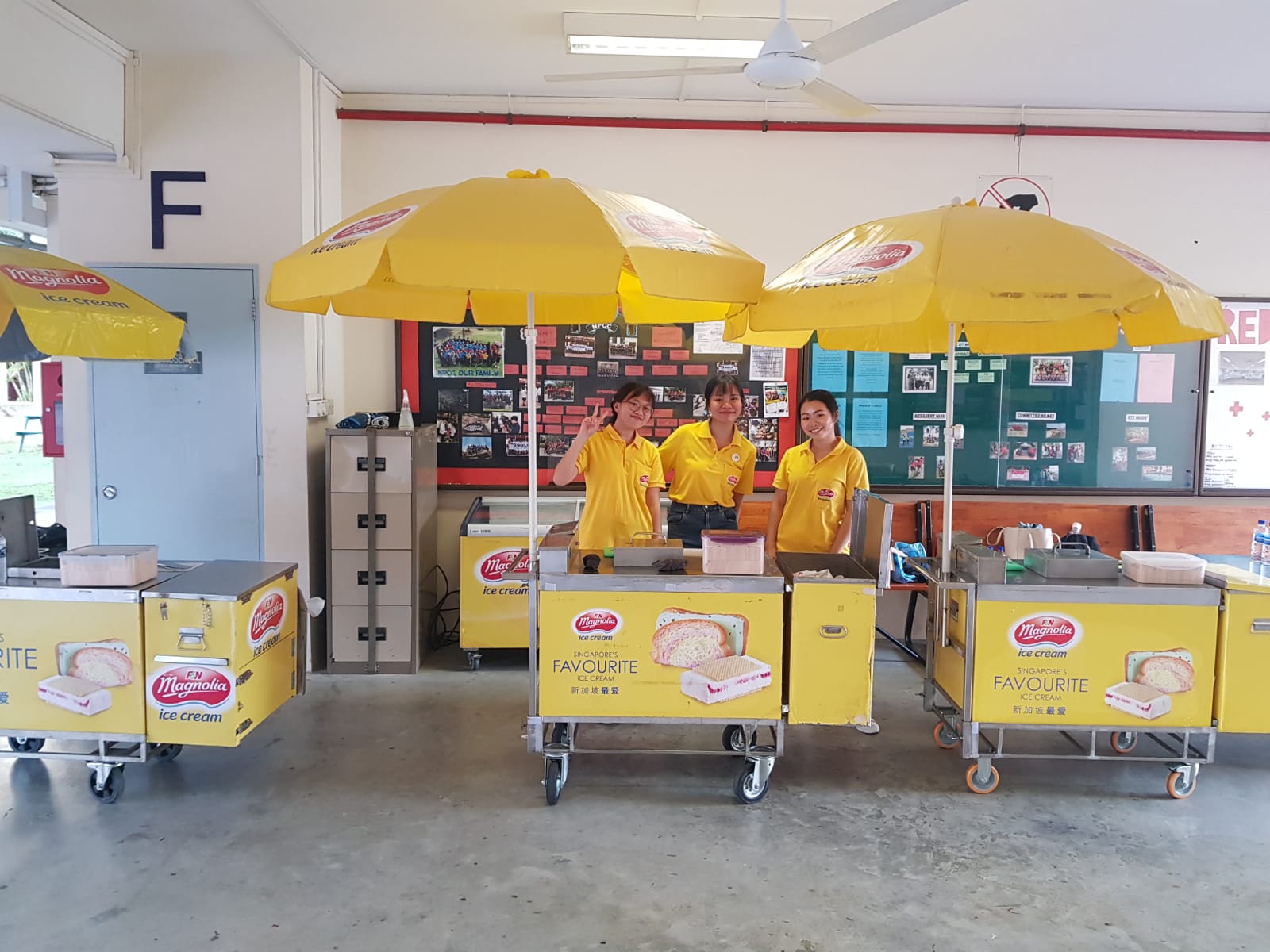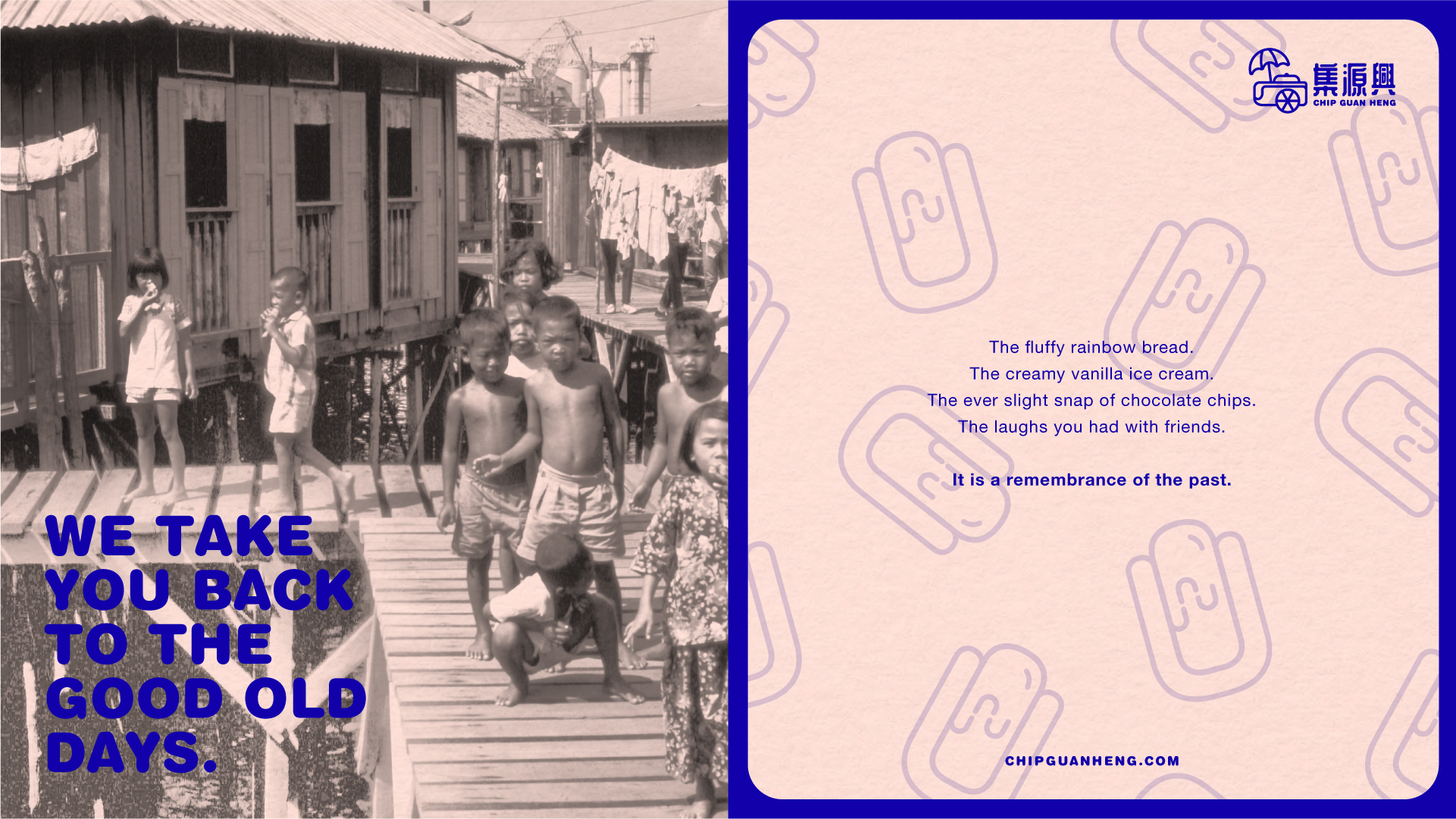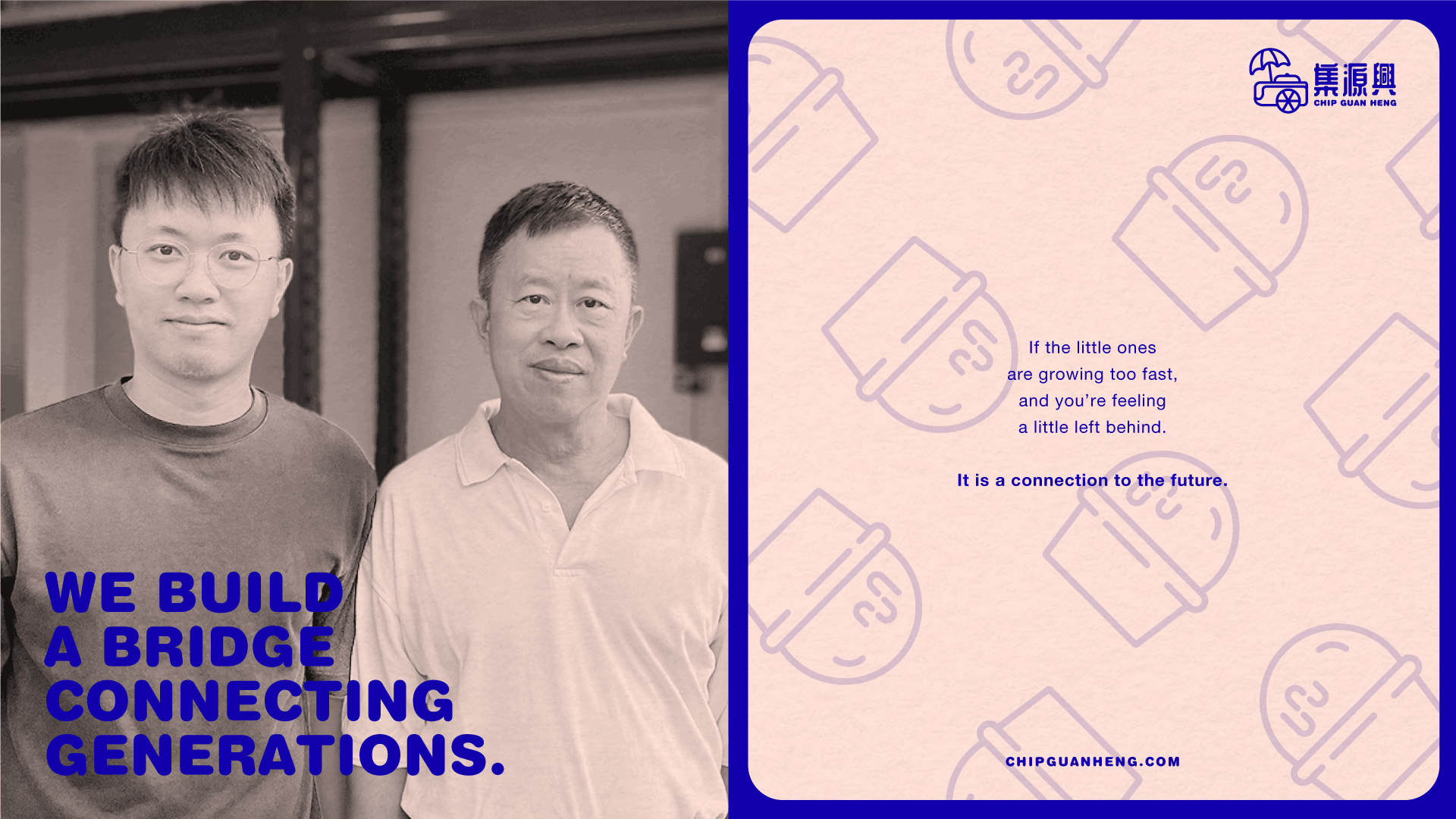Chip Guan Heng is a family business borne and built out of grit and hard work across five decades. Facing imminent threats from varying factors, it turned to branding–more specifically rebranding. Determined for the beloved local ice cream wholesaler to survive the next five decades and beyond, our team at Firefish embarked on a transformative rebranding journey with Chip Guan Heng.

Chip Guan Heng warehouse in the 1980s.
The Birth and Growth of a Brand
Chip Guan Heng (集原興) was founded by the late Goh Si Yam. He rode a cargo ship from China at the age of 8, started taking on odd jobs, and opened a provision shop in the 1960s. He also sold local brands of traditional ice cream to hawkers until eventually, he approached Cold Storage to obtain a Magnolia ice cream distribution license. In 1970, Goh Si Yam then opened an ice cream distribution business. For his brand new venture, Goh Si Yam picked the characters “集” (Chip), meaning gather, “原” (Guan), meaning resources, and “興” (Heng), meaning prosperity.
Cold Storage eventually sold Magnolia to F&N, and that was how Chip Guan Heng became a primary local F&N distributor. The wholesale ice cream business in currently in the hands of Goh Si Yam’s son, Mr Goh Soo Khin. His own son, Kenneth, is set on continuing the legacy and has also joined in the family business.
Today, Chip Guan Heng do not only supply traditional ice cream to street hawkers. The business includes event and catering services, as well as distributing wholesale gelato supplies to local shops like Apiary, Sweet Cheeks, Udders and Jolly Bean.
Threats to Brand Longevity
Phasing-Out of Street Hawkers
Like most businesses all over the world, Chip Guan Heng could not escape from the effects of the Covid-19 pandemic. But while pandemic-related restrictions have started to ease, Chip Guan Heng is facing yet another threat to its core business channel. The future of local traditional ice cream culture looks bleak, as Singapore’s government is intent on phasing out ice cream street hawkers. The last ice cream cart license was issued in 2004, while existing licenses are deemed non-transferable. For locals in particular, the tradition is undeniably disappearing. Ice cream hawkers used to be a common sight in every neighbourhood, but is now a rare encounter. As the number of street hawkers in Singapore gradually diminishes, Chip Guan Heng is forced to reconsider its business and brand strategy.

Ice cream street hawkers in Singapore, 1962. Courtesy of National Archives of Singapore.
Client-Turned Competitors
With the rise of hosting and reseller platforms like Shoppee and Lazada, the barrier to entry into the wholesale business is smaller than ever. As a result, former clients have started to directly partner up with manufacturers in order to set up wholesale businesses of their own. As the issue is inevitable given the circumstances, there is a pressing need for differentiation in the increasingly saturated market for wholesale ice cream. Conveying a brand positioning that is beyond an F&N distributorship is imperative if Chip Guan Heng were to prevail against this new wave of competitors.
Lack of Brand Awareness
Founded more than 50 years ago, Chip Guan Heng has grown to be one of the leading F&N Magnolia ice cream distributors in Singapore. However, it suffers from an over-reliance on F&N to provide branding and marketing materials. Besides the pressures of keeping costs low, the fact that Chip Guan Heng does not manufacture any of its own products translates to a limited capability to create its own brand touchpoints. This comes at the expense of a stagnant brand awareness despite its multi-generational industry presence.

Chip Guan Heng is Singapore’s leading distributor of F&N Magnolia ice cream.
Discovering New Opportunities
Through the brand audit process with Chip Guan Heng, we didn’t just uncover looming threats. But more importantly, we unearthed opportunities waiting to be seized upon; they are untapped avenues for Chip Guan Heng not just to weather the storm but to thrive and expand in the future.
Impacting on the Local Culture
Chip Guan Heng stands at a crossroads where it can significantly contribute to preserving Singapore’s local ice cream culture. By embracing its historical significance and becoming an advocate for this cultural legacy, Chip Guan Heng can extend its influence beyond selling products. Initiatives such as collaborating with local communities, hosting events celebrating traditional ice cream, or supporting educational programs on its history could cement Chip Guan Heng as a guardian of this fading cultural treasure.

Chip Guan Heng ice cream carts and servers in a local secondary school. This image was taken before the rebranding.
Expanding the Brand Positioning
To transcend being perceived solely as an F&N distributor, Chip Guan Heng could rework its brand touchpoints. Investing in distinctive point-of-sale packaging, delivery trucks adorned with Chip Guan Heng branding, and leveraging online platforms through engaging content and dynamic advertising can significantly enhance brand visibility. Creating a welcoming retail corner within the warehouse or employing moving advertisements such as truck livery can also attract foot traffic and drive online engagement, further distinguishing Chip Guan Heng from competitors.
Harnessing Heritage: Emotional Experience Over Product
Building on nostalgia is a powerful tool. Recognising the shift in consumer preferences towards experiential value, Chip Guan Heng has an opportunity to position itself beyond just selling ice cream. By weaving nostalgic elements into its story and fostering immersive, emotionally resonant experiences for consumers, Chip Guan Heng can elevate itself beyond the realm of simple ice cream sales. This strategic blend of heritage and emotional connectivity has the potential to forge enduring bonds with consumers, cultivating a brand identity that surpasses the transactional, fostering lasting loyalty and resonance in the market.



A series of marketing posters created during the rebranding exercise. Click here to view more.
Beyond A New Signboard
Though there was significant update on its brand identity, Chip Guan Heng’s rebranding wasn’t merely cosmetic. Beyond superficial changes like logo alterations or mission statements, the initiative went hand-in-hand with strategic, long-term business investments and core operational enhancements, contributing toward a deeper business evolution overall.
Mobile Wagon Licensing
In a bold move to directly engage consumers and create a new revenue stream, Chip Guan Heng ventured into mobile wagon licensing. This innovative approach sidestepped the challenges posed by the government’s halt on ice cream cart licenses. Securing the inaugural license at Marina Bay Sands in 2022 strategically positioned us to tap into local nostalgia and captivate tourists eager to savour Singapore’s iconic dessert culture.
Chip Guan Heng mobile wagon design and livery mockup.
Warehouse Renovation
Simultaneously, the Chip Guan Heng warehouse underwent a significant transformation. The aim? To streamline operations and fortify inventory management. As part of this overhaul, modern POS systems replaced old-fashioned invoicing methods, and QuickBooks was embraced for smoother accounting processes. Yet, the commitment to improvement went beyond digital upgrades. The warehouse layout was meticulously redesigned to enhance inventory control, ensuring greater accuracy and efficiency. The makeover also involved structural enhancements like a purpose-built mezzanine for dry goods storage and an expanded cooler room to accommodate more stock. The exterior makeover wasn’t just a paint job either; it aimed to visually represent the refreshed brand identity, as well as attract more footfall.
conclusion
When is it right to rebrand?
As a brand matures and adapts to changing landscapes, its branding must evolve in tandem. However, a rebranding that merely scratches the surface of brand identity is a missed opportunity for substantial growth. Genuine transformation transcends outward appearances; it necessitates an intrinsic realignment in the brand’s core values, operations, and consumer engagement strategies. The new identity becomes more than a design solution; it embodies and promotes the brand’s revitalised values and repositioning in the market. It’s a visual testament to the brand’s evolution, reflecting a commitment to staying relevant and resonating with its audience.



